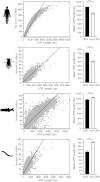No Evidence that MicroRNAs Coevolve with Genes Located in Copy Number Regions
- PMID: 25804521
- PMCID: PMC4560049
- DOI: 10.1093/molbev/msv073
No Evidence that MicroRNAs Coevolve with Genes Located in Copy Number Regions
Abstract
MicroRNAs (miRNAs) are a widespread class of regulatory noncoding RNAs with key roles in physiology and development, conferring robustness to noise in regulatory networks. Consistent with this buffering function, it was recently suggested that human miRNAs coevolve with genes in copy number regions (copy number variation [CNV] genes) to reduce dosage imbalance. Here, I compare miRNA regulation between CNV and non-CNV genes in four model organisms. miRNA regulation of CNV genes is elevated in human and fly but reduced in nematode and zebrafish. By analyzing 31 human CNV data sets, careful analysis of human and chimpanzee orthologs, resampling genes within species and comparing structural variant types, I show that the apparent coevolution between CNV genes and miRNAs is due to the strong dependency between 3'-untranslated region length and miRNA target prediction. Deciphering the interplay between CNVs and miRNAs will likely require a deeper understanding of how miRNAs are embedded in regulatory circuits.
Keywords: copy number variation; gene regulation; miRNA; regulatory networks; robustness.
© The Author 2015. Published by Oxford University Press on behalf of the Society for Molecular Biology and Evolution. All rights reserved. For permissions, please e-mail: journals.permissions@oup.com.
Figures


Similar articles
-
Increased number of microRNA target sites in genes encoded in CNV regions. Evidence for an evolutionary genomic interaction.Mol Biol Evol. 2011 Sep;28(9):2421-4. doi: 10.1093/molbev/msr078. Epub 2011 Mar 25. Mol Biol Evol. 2011. PMID: 21441354
-
Small but influential: the role of microRNAs on gene regulatory network and 3'UTR evolution.J Genet Genomics. 2009 Jan;36(1):1-6. doi: 10.1016/S1673-8527(09)60001-1. J Genet Genomics. 2009. PMID: 19161940 Review.
-
Copy number variation of microRNA genes in the human genome.BMC Genomics. 2011 Apr 12;12:183. doi: 10.1186/1471-2164-12-183. BMC Genomics. 2011. PMID: 21486463 Free PMC article.
-
Insights into the regulation of human CNV-miRNAs from the view of their target genes.BMC Genomics. 2012 Dec 18;13:707. doi: 10.1186/1471-2164-13-707. BMC Genomics. 2012. PMID: 23244579 Free PMC article.
-
Regulating Craniofacial Development at the 3' End: MicroRNAs and Their Function in Facial Morphogenesis.Curr Top Dev Biol. 2015;115:335-75. doi: 10.1016/bs.ctdb.2015.08.001. Epub 2015 Oct 1. Curr Top Dev Biol. 2015. PMID: 26589932 Review.
Cited by
-
Genome-Wide Assessment Characteristics of Genes Overlapping Copy Number Variation Regions in Duroc Purebred Population.Front Genet. 2021 Oct 14;12:753748. doi: 10.3389/fgene.2021.753748. eCollection 2021. Front Genet. 2021. PMID: 34721540 Free PMC article.
References
-
- Bartel DP. MicroRNAs: genomics, biogenesis, mechanism, and function. Cell. 2004;116:281–297. - PubMed
-
- Betel D, Wilson M, Gabow A, Marks DS, Sander C. The microRNA.org resource: targets and expression. Nucleic Acids Res. 2008;36:D149–D153. - PMC - PubMed
Publication types
MeSH terms
Substances
Grants and funding
LinkOut - more resources
Full Text Sources
Other Literature Sources

